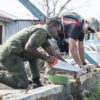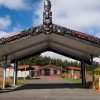By Mr S. Bartlett
The Background
The Future Land Operating Concept 35 [1] (FLOC 35) has indicated that there will continue to be a strong expectation that the New Zealand Defence Force will respond to instability and emergencies in the South-West Pacific. This instability is expected to occur as a result of ‘complex disruptors’ such as climate, terrorism and cyber threats (Strategic Defence Policy Statement, Rt Hon Ron Mark, 2018)[2]. Apart from cyber, this combination of disruptors is not new to the NZDF context – in fact, the successful reaction to these disruptors forms a significant part pride of the NZDF in the modern era. CONPLAN Pacific Relief, through activations in 2015 and 2016 to Cyclones Pam and Winston respectively, has provided a key example of NZDF capability to respond effectively to these events. The HMNZS Canterbury, with an embarked HADR Task Group formed from 2nd Engineer Regiment (2ER) and other Combat Support and Combat Service Support units has, and will continue to, form the nucleus of these Humanitarian Aid Disaster relief responses. As such, familiarity and interoperability with the key units that are likely to be involved in these responses is crucial.
However, within the three years preceding the COVID-19 pandemic, the opportunities afforded to the New Zealand Army to meaningfully integrate with the HMNZS Canterbury have been significantly limited in scope. This can be attributed to a variety of factors, which include but are not limited to;
- COVID-19 Pandemic (Resulting in the further delay of the Southern Katipo exercise);
- OP Protect; through limiting the ability and appetite for extended exercises supported by a wide variety of units;
- Unaligned training schedules between relevant units; and
- Training Outcomes not encompassing wide-scale Amphibious Operations
The Tropic Twilight and Croix de Sud exercises in May 2018 saw the last major training activity involving the Army and HMNZS Canterbury. While there have been several smaller scale training exercises and CPX’s since that time – none of them have meaningfully employed Canterbury as the nucleus of a NZ-led amphibious task force. The below list indicates the key activities that have involved both Canterbury and Army units since 2018. The unit indicated after the exercise name is the Army unit/Task Element involved.
Exercise Black Termite. This exercise in May 2019 deployed the Amphibious Beach Team and a small FRT from 2nd Workshop Coy, however did not involve other NZ Army units
Exercise Hamel. This saw HMNZS Canterbury provide a sealift role for Task Group Black to Australia, however, did not involve any amphibious operations.
Exercise Neptune Fury. This activity involved approximately 10 staff from 2ER, 2 CSSB and 1 CSR, as well as the High Readiness Task Unit. No amphibious lodgements were conducted – either via air or sea.
Exercise Joint Waka. This activity series in 2020 saw the ABT exercise with the Canterbury twice. The first involved four HX58’s from 3 CSSB and ten Combat Drivers. The second saw only the ABT deployed.
OP CALYPSO in November 2020 provided an opportunity for the operational provision of Humanitarian Aid and Disaster Relief to an island nation – with the ABT providing an Aerial Delivery capability. A total of approximately 15 personnel were contributed from the Army for this activity – ten of whom were the ABT that had participated in the Joint Waka series.
What the above demonstrates is that the New Zealand Army has not lodged a complete HADR task element within a typical posting cycle of two years. This indicates that skill fade, complacency and the consistently progressing capability enhancements of the Army have not had an opportunity to be fully exercised in the environment where they are likely to be employed. RPAS, CSS and Combat Support capabilities by their very nature can only be exercised to a limited extent without a Task Element to support, and the dynamic nature of HADR or SASO operations provide unique challenges for these units that cannot be effectively simulated when training in isolation.
The Result
The below key problems are likely to be encountered if a complex disruptor causes an event that the NZDF is required to respond to.
Capability/SOP Disconnect
The addition of new capabilities such as RPAS, the Beach Preparation Extraction Vehicle (BPEV) held by the ABT, and continuing developments with the HX series of vehicles will provide a series of unique challenges. There remains a disparity between the capacity of Canterbury’s Landing Craft Ramps and the vehicles employed by the NZDF. In particular, the axle weight limitations prohibit the employment of any laden HX58 or any HX77 variant across the ramp. Even if waivers are provided when CONPLAN PACREL is activated, this approach still encompasses significant risk of driving heavy vehicles into an amphibious environment where risk of drowning or vehicle loss are prevalent; especially when drivers are inexperienced in dealing with the unique challenges that driving from a landing craft presents.
The second example that may be encountered involves the International Maritime Dangerous Goods (IMDG) requirements of both new and existing capabilities when embarking on Canterbury. The management of these requirements is conducted primarily by individual C/RQMS’, with checks then conducted by Movement Operators from 5th Movements Company. The short lead times involved in preparing for a HADR amphibious operation (72 hrs), do not allow for integral CSS units to effectively understand IMDG requirements in advance. This places pressure on 5th Movements Company to oversee more of the mobilisation of 1(NZ) Brigade and NZDF units, increasing reliance at a time when the company may be unable to provide equal assistance.
Trade Skill/Qualification Lapse
The high tempo encountered in the Army environment requires units to consistently prioritise what courses and training activities are enabled and attended. Courses outside of trade requirements, will understandably be prioritised above other courses likely to manage risk in the amphibious environment. As the risk mitigating courses are only attended when exercises are scheduled, a period without such activities is likely to cause a lapse in these qualifications, but more importantly experience. For example, without a significant amphibious exercise or activity planned units are unlikely to send personnel on the Helicopter/Vehicle Underwater Extraction Training (HUET/VUET) – which is seen as a self-imposed requirement for the operation of vehicles across the stern ramp of Canterbury, or for personnel to embark rotary wing aircraft for ship-to-shore movement. This lack of qualification can be adjusted through policy; however, this does not effectively manage the risks that are prevalent in the amphibious environment.
Command Inexperience
The dynamic and time sensitive environment encountered in amphibious operations places additional pressures on commanders at all levels. These pressures include an inability to effectively rehearse, exceptionally decentralised command, breakdown in inter-service communications, and congestion within a small operating space. These factors can be overcome when commanders are afforded with experience and rehearsals through exercises and other combined training activities. This is particularly important when exceptionally decentralised command is combined with an unfamiliar communication set. This is exactly what mission command and intent based leadership is designed for, but this becomes increasingly challenging when units are dislocated across 12 Nm with very little CSS flexibility and responsiveness in the crucial opening stages due to LCM capability limitations.
A Solution
Each year, both 2ER and Canterbury conduct independent PACREL preparatory exercises in October-November at the beginning of the cyclone season – with 2ER conducting an annual SPX and Canterbury exercising internal serials for launching both aircraft and landing craft. The disconnect here remains that there are very rarely customer units deployed as part of this, with only a small headquarters staff from the NZ Army provided. As the Army draws down its OP Protect commitments, platoon-level elements with their full complement of vehicles and stores will begin to become available, which should then be capitalised on. The movement of customer vehicles as part of an amphibious task, including each stage involved in the deployment, embarkation, deployment and withdrawal of amphibious forces forms the critical phase of this joint training. These activities will provide a point of aim for HADR oriented units and reorient them towards the key tactical and trade skills that will have lapsed with an extended period without field assessment. If these platoon or greater sized elements are not effectively trained or employed in the preceding months to a potential callout, the risk of failure of one or multiple components of an amphibious operation may have a debilitating effect on the NZDFs ability to meet its designated outputs at the crucial moment that it is required.
Resources
- https://www.nzdf.mil.nz/assets/Publications/Future-Land-Operating-Concept-2035
- https://www.defence.govt.nz/assets/Uploads/8958486b29/Strategic-Defence-Policy-Statement-2018






